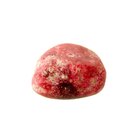
Medioimages/Photodisc/Photodisc/Getty Images
Evidence exists that cultivation of wheat may have begun over 9,000 years ago. Classification of wheat comes from a number of factors, such as texture and growing season. Two such classifications observed in the United States, hard white and hard red, differ in color, protein content and use.
Color
The most obvious difference between these two classes of wheat is color. This refers to the outer coating of the kernel, not the processed wheat. A red wheat germ has a rustic shell while white is lighter in color.
Genetics
Hard white wheat is genetically engineered from red wheat, according to Bob’s Red Mill. White wheat has been redesigned through the generations to reduce the bran in the kernel. Bran is the component that gives red wheat its distinctive coloring.
Protein Content
Hard red wheat will have more protein, up to 15 percent total, according to the Utah State University. Hard white wheat will have moderate protein content, considerably less than the red. The protein content affects the texture of baked foods that use flour from either grain. For instance, the high-protein count in red wheat is suitable for hard bread loaves. White works well for softer breads.
Flavor
Bob’s Red Mill claims one significant difference between these two classifications of wheat is taste. The genetic engineering of white wheat has given it a flavor that differs from it parent wheat. Red wheat tends to be bitter. To compensate, bakers add additional sweeteners to recipes that disguise the taste. White is engineered to reduce this bitterness. Goods produced with hard white wheat require fewer sweetening agents.
Making a Choice
Ultimately, the determining factor will be preference. Some people will want the milder and sweeter flavor of hard white wheat. Others may desire the firm texture associated with products made from hard red wheat. Another consideration may be availability. Ohio State University reports that 40 percent of wheat crops in the United States are hard red winter wheat. Red wheat may be easier to find in some areas. Both forms of wheat have gluten. If you are sensitive to gluten, neither for will be suitable for you. Talk to your doctor about gluten products and foods that you should avoid.
Related Articles

Difference Between Red & White Wheat

How to Identify Red Jasper

Kamut Vs. Wheat

Difference Between Sebastian ...

What Makes Food Coloring Darker When ...

The Difference Between a Red Quinoa & a ...

How Long Do I Cook Vermicelli?
Can You Substitute Whole-Wheat Pastry ...

Cubic Zirconia Vs. White Spinel

Can You Substitute Whole Wheat Pastry ...

Difference Between Red Rice & Brown Rice

Substitute for Gram or Besan Flour

White Vs. Yellow Popcorn

Calories in a Cheese Roll

Difference Between Permanent Hair Color ...

Physical Characteristics of the Ruby ...
What Is the Difference Between Cake ...

What Are Ingredients in Wheat Bread?

Alternative Flours to Make Pizza
Is Unbleached Flour the Same as ...
References
Writer Bio
Writing since 1999, Darla Ferrara is an award-winning author who specializes in health, diet, fitness and computer technology. She has been published in "Mezzo Magazine" and Diet Spotlight, as well as various online magazines. Ferrara studied biology and emergency medical technology at the University of Nebraska and Southeast Community College.
Photo Credits
Medioimages/Photodisc/Photodisc/Getty Images